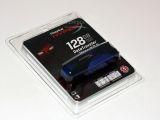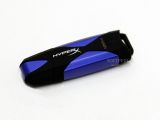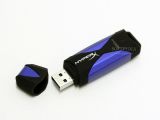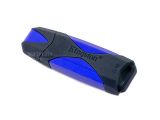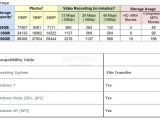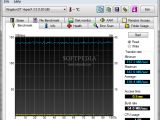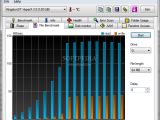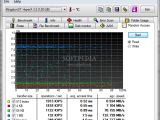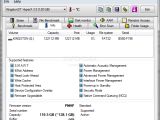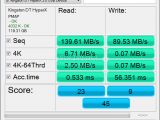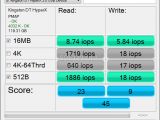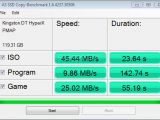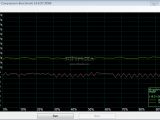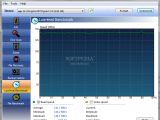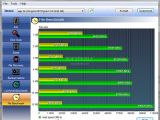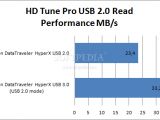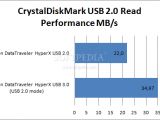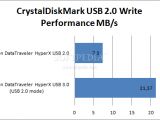When it released the DataTraveler HyperX USB 3.0 Flash drive, Kingston said that its USB 3.0 dongle could offer SSD-like performance without the bulk of a regular solid state unit. We were so intrigued by these claims that we decided to take the drive for a spin to see how well it performs in the real world.
The DataTraveler HyperX USB 3.0 isn't actually the first Kingston drive to be touted by the company as an SSD-like Flash drive as that “honor” belongs to the DataTraveler Ultimate 3.0, launched back in September of 2010.
However, things have changed since then, and what was actually introduced as one of the fastest USB 3.0 Flash drives around has now become more of a mainstream solution, as far as performance goes.
Kingston did actually improve the performance of the Ultimate 3.0 with the introduction of a revised version, but in order to take back the crown, a faster solution was needed.
It is here where the Flash drive we are reviewing today enters the stage, coming as the first HyperX-branded USB 3.0 Pen Drive to be released by the company.
As all of Kingston's HyperX products, the new DataTraveler USB 3.0 drive is targeting enthusiasts and those users requiring no-compromise performance, so while it may be fast, it doesn't fit the needs of all types of users out there.
Why does that happen, you might ask. Well, as any enthusiast product, the DataTraveler HyperX USB 3.0 is by no means cheap, with the “entry-level” 64GB version being priced at $149 (117.6 EUR), while the 128GB model we are reviewing today has an MSRP of $250 (197 EUR).
For those of you requiring even more storage space, Kingston is also readying a 256GB version of the drive, but this hasn't been priced so far.
Aesthetics and Design Much like other Kingston Flash drives, the DataTraveler HyperX USB 3.0 comes in a hard plastic package that offers a peak at the USB 3.0 dongles inside, as well as some basic info about its performance.
Although this certainly does a good job at presenting the product, the bad news is that it may prove particularly difficult to open, so you might need a sharp pair of scissors or a cutter to open it.
You should pay great attention to what you're doing during this process as it's not that hard to cut yourself in the hard plastic used by Kingston.
Once you get the drive out of the package, the first thing that draws your attention is the attractive external design of the DataTraveler HyperX, which uses a blue metallic-looking plastic case paired with a black X-shaped rubber surface.
The blue plastic really fits quite well with the HyperX color scheme, while the angular design of the case does seem to resemble a bit the stealth bombers used by the US military.
Design wise, there isn't much else to say about the DataTraveler HyperX USB 3.0, except for the fact that the cap snaps to the drive firmly with a reassuring “click” sound, definitely a nice touch for those of us not wanting to get stuck with a capless DataTraveler HyperX.
Specifications
Capacities: 64GB, 128GB, 256GB Dimensions: 2.952" x 0.916" x 0.626" (74.99mm x 23.29mm x 15.9mm) Operating Temperature: 32°F to 140°F (0°C to 60°C) Storage Temperature: -4°F to 185°F (-20°C to 85°C) Practical: durable casing with a solid lanyard loop Speed: USB 3.0: 225MB/s read and 135MB/s write USB 2.0: 30 MB/s read and 30MB/s write 8-Channel Architecture Backwards Compatible with USB 2.0 ReadyBoost Support Guaranteed: five-year warranty, 24/7 technical support
As you can see from the specs provided by Kingston, the DataTraveler HyperX USB 3.0 is expected to offer transfer rates of up to 225MB/s when connected through USB 3.0, which is consistent with the speeds offered by SSDs in 2010.
Even today, some low-end internal SSD drives have troubles reaching such speeds, so the fact that a compact Flash Drive can promise this type of performance is a testament to Kingston's engineering efforts.
In case you are wondering how this is possible, the answer lies in the 8-channel architecture used by Kingston for the DataTraveler HyperX USB 3.0.
What this basically means is that Kingston managed to cram eight Flash NAND chips in the HyperX Flash drive together with an SSD controller, the latter communicating with all the memory chips simultaneously in order to significantly boost performance.
In the DataTraveler HyperX USB 3.0, Kingston populates all these channels with memory, no matter the capacity of the drive, in order to keep performance consistent between all three models (64GB, 128GB and 256GB).
This doesn't usually happen in the SSD world, where most manufacturers, in order to save costs, populate all the memory channels available from the controller only in larger capacity drives.
This is why performance usually varies between, let's say, a 64GB and a 256GB SSD released in the same series by a solid state drive maker.
Besides the standard USB 2.0 compatibility and ReadyBoost support, the only other piece of info provided in the specs list that is worth mentioning is the five-year warranty and 24/7 technical support that Kingston is offering for the DataTraveler HyperX USB 3.0.
With the specifications of the Kingston Flash drive out of the way, it's now time to take a look at its performance, but not before we review the system used for these tests.
Testing platform
Intel Core i7-860 2.8GHz processor Gigabyte P55A-UD4 motherboard NVIDIA GeForce GTX 260 GPU 4GB Kingston Kingston Hyper X DDR3-1333MHz memory Western Digital Caviar Black 500GB SATA hard drive Integrated Audio and Network Windows 7 Professional 64-bit Operating system The Gigabyte P55A-UD4 motherboard used comes with built-in USB 3.0 thanks to the integration of a NEC (Renesas) µPD720200 controller.
According to its maker, this controller should be able to support the full 5Gbps (500MB/s since USB 3.0 uses the 10-bit format), which is more than double the read speeds that Kingston says the DataTraveler HyperX USB 3.0 can achieve.
To put the performance of Kingston's new Flash drive in perspective when used in the USB 2.0 mode, we also included the results achieved by a Kingston DataTraveller USB 2.0 drive for comparison purposes.
Performance Kicking things off in the USB 3.0 performance sector of our review is the HD Tune benchmark, pretty much the de facto standard when it comes to testing storage devices.
As I am sure many of you know, HD Tune is primarily being used for testing the sequential transfer speeds achieved by storage drives, an area in which the DataTraveler HyperX USB 3.0 should fare quite well, and our tests confirm that.
While it doesn't manage to hit the speeds touted by the manufacturer, the Kingston drive is indeed extremely fast and manages to reach some impressive transfer rates for a drive its size.
Furthermore, the rest of the benchmarking applications present in our test suite confirm these numbers, so as far as sequential performance is concerned, the DataTraveler HyperX USB 3.0 manages to deliver on its promise.
However, things take a turn for the worst when we consider the 4K random write performance of the Kingston Flash drive, which seems to struggle when a large set of small files are to be transferred.
The good news is that most users won't find themselves all that often having to transfer such a large number of small files to make the DataTraveler HyperX USB 3.0 feel slow, as this type of usage scenario is usually reserved for operating systems.
This is why 4K random performance is so important for internal SSDs, which are often used to boot drives for the OS.
For external storage drives this is far less of a concern, so if I were to guess, I would say that Kingston has deliberately tweaked the DataTraveler HyperX USB 3.0 firmware for raw transfer speeds instead of random 4K performance.
The file copy test in the AS SSD benchmark goes to show just how small of an impact random 4K reads/writes have over popular file transfer tasks.
While the new Kingston DataTraveler HyperX is a USB 3.0 drive, we also took our time to test the USB 2.0 performance of the Flash drive, since this may still be of some importance to most of you.
After all, a Flash drive is designed to be portable and even though USB 3.0 has seen widespread adoption in the last year or so, sometimes you may still be forced to use the DataTraveler HyperX on a USB 2.0-only computer.
Needless to say, when running in this mode, the transfer speeds of the Kingston Flash drive will be severely limited to a maximum of about 30MB/s, according to its maker.
Taking a look at the results provided by HD Tune and CrystalDiskMark, it becomes apparent that both of these benchmarks pretty much agree with Kingston's claims.
CrystalDiskMark does report lower than 30MB/s results when writes are concerned, but at 21MB/s the drive is still pretty fast for the USB 2.0 interface as long as 4K random writes aren't involved.
When compared to the USB 2.0-only DataTraveller HyperX Flash drive, Kingston's new creation surpasses it without any problems, particularly when writing to the drive.
Conclusions Kingston touts the DataTraveler HyperX USB 3.0 as being the fastest Flash drive in existence and while we can't confirm this as we haven't tested all the USB 3.0 dongles available today, we can say that Kingston's creation is one particularly fast drive.
Its sequential transfer speeds can even put some entry-level SSDs to shame, which is definitely something to take great pride in.
Random 4K performance is certainly nothing to write home about, but the compromise is well worth it, considering you won't be using it as a boot drive.
With these being said, the most important downside of the DataTraveler HyperX USB 3.0 is its pricing. At $149 for the 64GB model, Kingston's Flash drive is particularly expensive, so unless spending half of your time transferring data between USB 3.0-enabled PCs, the money could be used for upgrading your hardware.
On the other hand, if you are an enthusiast obsessing about the fastest tech around, or money is no object to you, the DataTraveler HyperX USB 3.0 is a great buy, since it has the speed and the capacity to fulfill your every wish.
The Good:
- High sequential transfer speeds - High capacity - Great looking - Five-year warranty
The Bad:
- $149 base price - Low random 4K performance
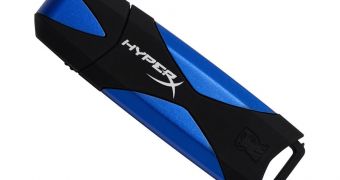
 14 DAY TRIAL //
14 DAY TRIAL // 
